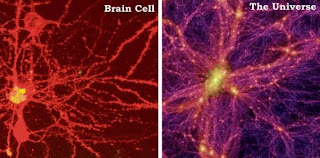 |
|
Means of Reproduction no. 627
|
 |
|
Means of Reproduction no. 701
|
Steven Strogatz on
Sync, TED2004
Mathematician Steven
Strogatz shows how flocks of creatures (like birds, fireflies and fish) manage
to synchronize and act as a unit -- when no one's giving orders. The powerful
tendency extends into the realm of objects, too.
“What do you need to produce spontaneous synchronization? Do
you need to be alive? No. [There is a] Deep tendency towards order in nature
that opposes what we've been taught about entropy. [The tendency towards
spontaneous order is a counter force.]”
How swarms work, 3 (+1) rules:
1. all the individuals are only aware of their nearest neighbors
2. all the individuals have a tendency to line up
3. they're all attracted to each other, but they try and keep a small distance apart
(4.) when a predator is coming, get away
 |
video still:
at ~14 minutes, he entrains de-synchronized metronomes via a common substrate
|
Entrainment (physics)
Entrainment
has been used to refer to the process of mode locking of coupled driven
oscillators, which is the process whereby two interacting oscillating systems,
which have different periods when they function independently, assume a common
period. The two oscillators may fall into synchrony, but other phase relationships
are also possible. The system with the greater frequency slows down, and the
other speeds up.
Entrainment
(biomusicology)
Entrainment in the biomusicological
sense refers to the synchronization of organisms to an external rhythm, usually
produced by other organisms with whom they interact socially. Examples include
firefly flashing, mosquito wing clapping as well as human music and dance such
as foot tapping.
Brainwave entrainment
Brainwave
entrainment or "brainwave synchronization," is any practice that
aims to cause brainwave frequencies to fall into step with a periodic stimulus
having a frequency corresponding to the intended brain-state (for example, to
induce sleep), usually attempted with the use of specialized software.
see also:
In his lab at Penn,
Vijay Kumar and his team build flying quadrotors, small, agile robots that
swarm, sense each other, and form ad hoc teams -- for construction, surveying disasters
and far more.
How Music Works
David Byrne, in describing a process of whittling-down
potential dancers in his group, recounts the following experience
Noemie began with an exercise I’ve never forgotten. It
consisted of four simple rules:
- Improvise moving to the music and come up with an eight-count phrase. (In dance, a phrase is a short series of moves that can be repeated.)
- When you find a phrase you like, loop (repeat) it.
- When you see someone else with a stronger phrase, copy it.
- When everyone is doing the same phrase the exercise is over.
It was like watching evolution on fast-forward, or an
emergent lifeform coming into being. At first the room was chaos, writhing
bodies everywhere. Then one could see that folks had chosen their phrases, and
almost immediately one could see a pocket of dancers who had all adopted the
same phrase. The copying had begun already, albeit just in one area. This
pocket of copying began to expand, to go viral, while yet another one now
emerged on the other side of the room. One clump grew faster than the other,
and within four minutes the whole room was filled with dancers moving in
perfect unison. Unbelieavable! It only took four minutes for this evolutionary
process to kick in, and for the “strongest” (unfortunate word, maybe) to
dominate. It was one of the most amazing dance performances I’ve ever seen. Too
bad it was over so quickly, and that one did have to know the rules that had
been laid out to appreciate how such a simple algorithm could generate unity
out of chaos.
After this rigorous athletic experiment, the dancers rested
while we compared notes. I noticed a weird and quite loud wind like sound,
rushing and pulsing. I didn’t know what it was; it seemed to be coming from
everywhere and nowhere. It was like no sound I’d ever heard before. I realized
it was the sound of fifty people catching their breath, breathing in and out,
in an enclosed room. It then gradually faded away. For me that was part of the
piece, too.
How Music Works,
David Byrne, 2012, pp. 67-68











































